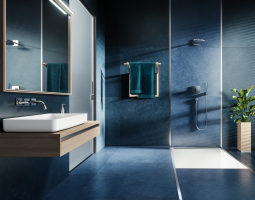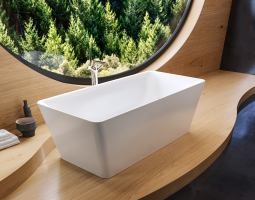
Koupelny
“WHAT DOES A TYPICAL BATHROOM IN ICELAND LOOK LIKE?
I thought about your question and probably the most accurate answer would be “small‘,“ says Ingibergur Thor Olafarson.How did I get to the idea to write about bathrooms in Iceland, who is Ingi and where did I meet him? The volcano is to blame for everything, my dear folks. And although this time it is a story with a rather bittersweet taste, as an eternal optimist, I hope that it will eventually bring something positive.

Black fittings and accesories dominate the bathroom segment across all countires.
Source: I. T. Ólafarson
Part one – bathrooms
„Bathrooms in Iceland are also warm and cozy,“ he adds after a while. I note that he didn’t quite send me such photos but we’ll get to the subject of heating right away and you’ll understand that it simply has to be warm in any case. When I started looking at the materials that was sent to me, I discovered some positive aspects when it comes to showers in one of the first photos. What I didn’t understand was the question of whether they use bathroom radiators for combined heating. There is no such thing as electric heating in Grindavik – hot water is supplied to the houses from the geothermal power plant north of town. It is said that in Grindavik you can shower for 12 hours straight. And how silly my question was is described in Ingi’s answer: „But of course you have to mix hot water with cold water, otherwise you’ll burn yourself.“
Hot water costs nothing in Iceland compared to other countries. And for example, charging a Tesla at home costs me around 7-8 dollars because we get electricity from water sources – rivers and waterfalls but everything else is expensive here.“

The incriminating connection for heating that cost me honor and pride – professional. Source: Ingibergur Thor Ólafarson
As for the bathroom segment, Starck sanitary ware from Duravit cost plus minus the same as here because, of course, I did a little research. The designer bathrooms I saw on Instagram are not very different from „ours“. I saw Vola or Gessi fittings, the aforementioned sanitary ware from the designer Philippe Starck, kitchen islands lined with large-format ceramics from companies that are commonly used here as well. I didn’t want to put any of that here because the only thing that will be familiar to you in these photos of the bathrooms are the cover plates for the toilet (Grohe and Tece) and it would be a shame to mix that authenticity with anything.

Grohe Arena Cosmopolitan cover plate. Source: I. T. Ólafarson
What they generally handle very carefully and thoughtfully is daylight and if there’s even a little chance of letting it into the bathroom, they’ll do it. Also note that you will not find a sink without a cabinet in a single photo. In the vast majority of cases, these are counter sinks embedded in slab.

There’s never enough daylight – especially in Iceland. Source: I. T. Ólafarson

Cabinets under sinks are not missing in any bathroom. Source: I. T. Ólafarson
But when you’re surfing the Internet, try to look at the Italian ceramic company Terratinta Group – these are handmade tiles and floor tiles and they are simply beautiful. I learned about it thanks to this text because designers in Iceland discovered this ceramic shop a long time ago.
I promise you that within a year, I will write a new article, much more comprehensive and detailed because I will go there to see those bathrooms in person.
And why didn’t I ask Ingi for more information?
Because….
Part two – who is Ingi?
Ingibergur Thor Ólafarson is a photographer from Grindavik, a fishing town on the Reykjanes peninsula that had to be evacuated on November 10th, last year due to the eruption of the Svartsengi volcano.
It is Ingi, who takes pictures of properties among other things. And one day the idea was born. And yes, none of the roads are paved with good deeds as much as the roads to hell…

The power of nature – beautiful and terrifying at the same time. Source: I. T. Ólafarson
The longer I followed the fates of the inhabitants of this town, the more suffering this text became for me. As many of you know, my language (in this case the keyboard) is often faster than my thoughts and so my original intention to bring him to other thoughts immediately punished me.
The crack that formed in Grindavik ends just a few tens of meters from his house. The latest eruption behaves completely differently from the previous ones and even though it is slowly weakening, it is not over yet. Grindavik is now an orphaned town, where people will not return anytime soon.
As of 03/28/2024, 546 homeowners from Grindavik turned to Porkatla, a specially created real estate company (financed by the government, disaster fund and credit institutions) to buy their properties. There is a total of 960 houses eligible for sale. It probably does not have to be mentioned that the houses are not bought for their market value.

The problem in Grindavik isn’t what’s visible, but what happened underground after the eruption. The eruption caused massive ground deformations, and within hours, cracks, cavities, and even complete cave systems were formed. Source: I. T. Ólafarson
However, the thing that really surprised me was the reaction of the rest of the world. You really haven’t noticed that? Very correctly, no reaction took place. If this happened anywhere else in third world countries, a natural disaster would undoubtedly be declared and aid would follow, in whatever form. Especially us, Czechs, can be proud of ourselves in this regard, as we consistently help everyone else. And surely many of us would also help the residents of Grindavik if someone started to deal with their natural disaster. But nothing happened.
If anyone knows the answer to this (unspoken) question, I will appreciate the answer.
On the other hand, it should be noted that when things are at their worst, one really laughs a lot. Yes, you read that right.
You can read Ingi’s whole story on his Instagram profile in the selections or on the link I attach at the end.

Volcano, full moon, and northern lights. Source: I. T. Ólafarson

Source: I. T. Ólafarson
Part three – is it safe to travel to Iceland?
It definitely is.
Don’t cancel your plans, don’t cancel your trips. There is nothing to be afraid of. Not only Icelandic journalists and photographers but also Dr. Matthew Roberts, Executive Director of the Icelandic Meteorological Office assures us of that. More information can be found both on their website and on VisiteIceland.com.
Just don’t go to Grindavik – the town is closed, you can only get there with a special permit for journalists with a guide and a gas mask. In addition to saving you an unnecessary trip, I know for sure, that it is also very unpleasant for the residents of Grindavik themselves. No one wants to feel like an attraction, especially when your life just fell apart.
Only a handful of my closest friends know that I have always wanted to see two things in my life – a volcano and a tornado. But I’m not so sure about the volcano anymore.
On the other hand, the view of the volcano, the aurora borealis and the full moon is something that I should definitely not deprive you of. And above all, I don’t want to either.
The promised good should come to an end and in the end it will come, I am firmly convinced of that, when it is over.

Some scenes are downright surreal. Source: I. T. Ólafarson
Thanks
To Ingi – for the photos, for his kindness and for sharing his story with me, even though it must have been difficult. I promise I will never forget to mix hot water with cold!
Contact:
https://www.instagram.com/ingib.thor/?igsh=MTd3NzZoNmYzOXlsdQ%3D%3D
To my friend Misha. Michaela Zeissova translated this text into English for me and she is not only a great teacher of English language but also a court interpreter and translator. Do not hesitate to contact her any time.
Contact: michaela.zeissova@seznam.cz
Jeroen Van Nieuwenhove – a Belgian living in Iceland, a lover of volcanoes and a photographer, thanks to whose channel Volcanic Activity in Iceland on Instagram I was (and still am) perfectly informed about what is going on there. I take my hat off to his highly professional work. And, of course, I recommend following him on Instagram or signing up for a drone photography course.
Contact:
https://www.instagram.com/jvn.photo/?igsh=MWJpMHptM2UwYWN5dA%3D%3D
And to Kubík!
PS – If Ingi is a typical representative of the male population in Iceland, it’s time to start thinking about life on the island, ladies….
- Zdroj: Ingibergur Thor Ólafarson
- Zdroj: Ingibergur Thor Ólafarson
- Zdroj: Ingibergur Thor Ólafarson
- Zdroj: Ingibergur Thor Ólafarson
- Zdroj: Ingibergur Thor Ólafarson
- Zdroj: Ingibergur Thor Ólafarson
- Zdroj: Ingibergur Thor Ólafarson
- Zdroj: Ingibergur Thor Ólafarson
- Zdroj: Ingibergur Thor Ólafarson
- Zdroj: Ingibergur Thor Ólafarson
- Zdroj: Ingibergur Thor Ólafarson
- Source: I. T. Ólafarson
- Zdroj: Ingibergur Thor Ólafarson
- Zdroj: Ingibergur Thor Ólafarson
- Source: I. T. Ólafarson
- Zdroj: Ingibergur Thor Ólafarson
- Zdroj: Ingibergur Thor Ólafarson
- Zdroj: Ingibergur Thor Ólafarson
- Zdroj: Ingibergur Thor Ólafarson
- Zdroj: Ingibergur Thor Ólafarson
- Zdroj: Ingibergur Thor Ólafarson
- Zdroj: Ingibergur Thor Ólafarson
- Zdroj: Ingibergur Thor Ólafarson
- Zdroj: Ingibergur Thor Ólafarson
- Zdroj: Ingibergur Thor Ólafarson
- Zdroj: Ingibergur Thor Ólafarson
- Zdroj: Ingibergur Thor Ólafarson
- Zdroj: Ingibergur Thor Ólafarson
- Zdroj: Ingibergur Thor Ólafarson
- Zdroj: Ingibergur Thor Ólafarson
- Source: I. T. Ólafarson
- Zdroj: Ingibergur Thor Ólafarson
- Zdroj: Ingibergur Thor Ólafarson
- Zdroj: Ingibergur Thor Ólafarson












































You must be logged in to post a comment Login